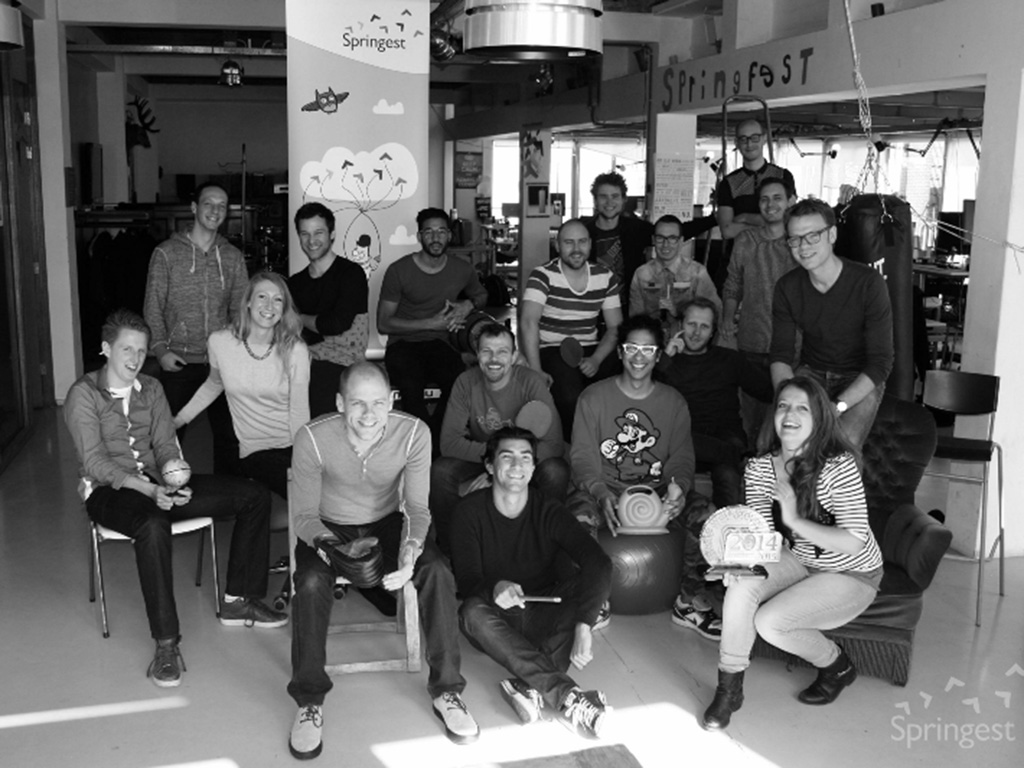Written by Debbie van Veen and published at medium.com
 Today we’d like to share with you the story of a woman who really appreciates owning her work and advancing her work in her own way. Debbie van Veen is a member of the Springest team and along with her colleagues she is working on developing “the Amazon of Learning”. Despite being only in her twenties, Debbie has already experienced both a traditional, hierarchical company structure and a self-organizing counterpart. She shares her insights with us about being part of both environments.
Today we’d like to share with you the story of a woman who really appreciates owning her work and advancing her work in her own way. Debbie van Veen is a member of the Springest team and along with her colleagues she is working on developing “the Amazon of Learning”. Despite being only in her twenties, Debbie has already experienced both a traditional, hierarchical company structure and a self-organizing counterpart. She shares her insights with us about being part of both environments.This is who I am.
Before I joined Springest, I worked as part of a hierarchical company for a while, where we had managerial levels. It was a good company with open-minded people. We were given a certain level of freedom. However, almost every time I tried to use this freedom, my initiatives would collide with managers trying to exercise their control. I wanted to change things; improve processes. Many times I was told that “that is not my job”. It made me feel out of place. I felt stifled in my ability to fully contribute. Wanting to make a meaningful contribution is simply part of my nature. This is who I am.
We used to think, “What the heck is this H-thing!”
It is funny to think back on the first impressions we had about Holacracy. One day, Diederick Janse came to Springest for a visit. I remember people reacting quite strongly to the ideas Holacracy introduces. Holacracy proposes a new mindset; it is a radical change. No doubt there is some resistance present at the beginning. Now, I can honestly say, I can no longer imagine working any other way! Holacracy revolutionized our world. Personally, I loved it from the beginning, because it was so different from what I was used to in my previous workplace.
Two reasons for lower stress with Holacracy
We have many interesting discussions at Springest. We love expanding on different topics. The other day, we had a conversation with Ruben (Ruben Timmerman, the founder of Springest) about burnout and other harmful, stress-related conditions. Our conclusion was that we are now less prone to developing them. In Holacracy you are not your job. In other companies, a job becomes your identity, your function profile. Conversely, in Holacracy you create a role not because of or for a person. You create a role for one purpose only: to get things done. A role is not a synonym of a person. It is a separate “living” thing. And I think that what happens is that if you separate the person from the role, people start to feel less stressed.
Another very distinctive trait of our environment is the lack of managers. There is no one here who is going to micro-manage me, pressure me and so on. Ah! Everyone knows this kind of situation: “Anna, you have to finish this report and give it to me by tomorrow noon!” This leads to a person sitting up at night, stressing, not feeling well and all that just to make sure they get it done before the deadline, even though this might not even be essential for the company at all. There might be dozens of other things that would add more value! You know, I don’t mind working overtime, not at all, but here at Springest I just do that spontaneously whenever I feel it is needed. We are all rational creatures and we can prioritize, communicate and deliver in a timely manner. We do not need to be pressured to pull our weight. In Holacracy, everything springs from the inside. It is all about intrinsic motivation. I want to fulfill my roles, I want to contribute and be as effective as possible. So, we are achieving the same or even more, without negative side effects.
I think we work harder now than we did before we were introduced to Holacracy. Despite that, we feel more energetic! I can decide for myself when I want to work on a particular item. This allows me to manage my work based on my energy levels, which turns out to be a much more productive approach compared to just time management.
Continuous evolution will always keep us moving in a positive direction
Within the circles, people often come up with new ways of getting things done. We often think of ways to improve our results. Therefore, the roles and the circles are constantly evolving. This way, our business also evolves and adapts. We do not stand still and I think this is great for Springest! The outside world is quickly evolving and we are able to stay up-to-speed. Let me give you a few examples. If my colleagues see a need for a new project or product, Holacracy gives them tools to make sure it gets integrated into our organization immediately. If something changes, and I start taking a repetitive individual action, each governance meeting gives me and others an opportunity to capture this new action into a clear accountability or a role.
Another example refers to our quarterly reviewed OKRs (Objective and Key Results). We actually did that a few days ago. The new OKRs brought a tension that got resolved during one governance meeting. We merged two circles to achieve a better fit for our new objectives. It was a substantial change for a company, but with Holacracy both small and big changes, occur organically. Therefore, we are continuously evolving in a seamless way. It feels like embracing Holacracy and an evolutionary approach is in the Springest DNA 🙂

Three key traits of Holacracy-style meetings
Results-oriented: During the tactical meetings, all the tensions turn into tangible next-actions for roles. “Create project XYZ”, or “Specify terms of contract X”, are examples of actionable items we get out of each tension we bring in. That is quite different from the traditional way of running meetings that I experienced in my past. I used to leave them with unresolved issues and fuzzy decisions that everyone felt confused about.
I love that people know what to expect of me. With the transparency Holacracy offers, it is always clear to everyone who is responsible for what. You know who to turn to; who has authority over what issue. This makes the decision-making process much faster.
Rigidness: I like it! I compare our meetings with other meetings I attend outside of Springest. I hate to say it, but often they are nothing more than a waste of time. People just switch topics, the loudest voices are heard and a chairman always has the last word… it is basically just chaos. You are not given space to say what you really think; to resolve your roadblocks and contribute. At the end of each meeting I have just one thought in my head, “I didn’t even get to say what I wanted”. It is so demotivating! With Holacracy the meetings are quite rigid. That means that there are rules that apply to everyone equally. We flow through each meeting by following strictly stipulated steps that allow us to truly process issues in a productive manner.
Space and time: With Holacracy I know it is normal to feel tensions. If I know there is something to process, I process it. I think that expressing your needs and impediments is easier in Holacracy, especially for people who are shy by nature. Everyone is given time and space. So you do not have to be loud to be heard. With Holacracy we experience equality. The system is there for each and every one of us. What I like most about Holacracy is that during the meetings, I bring a tension and I speak directly about my tension, in reference to my role. This is important to me personally, because I used to spend quite a bit of time chit-chatting. Now things get done!




